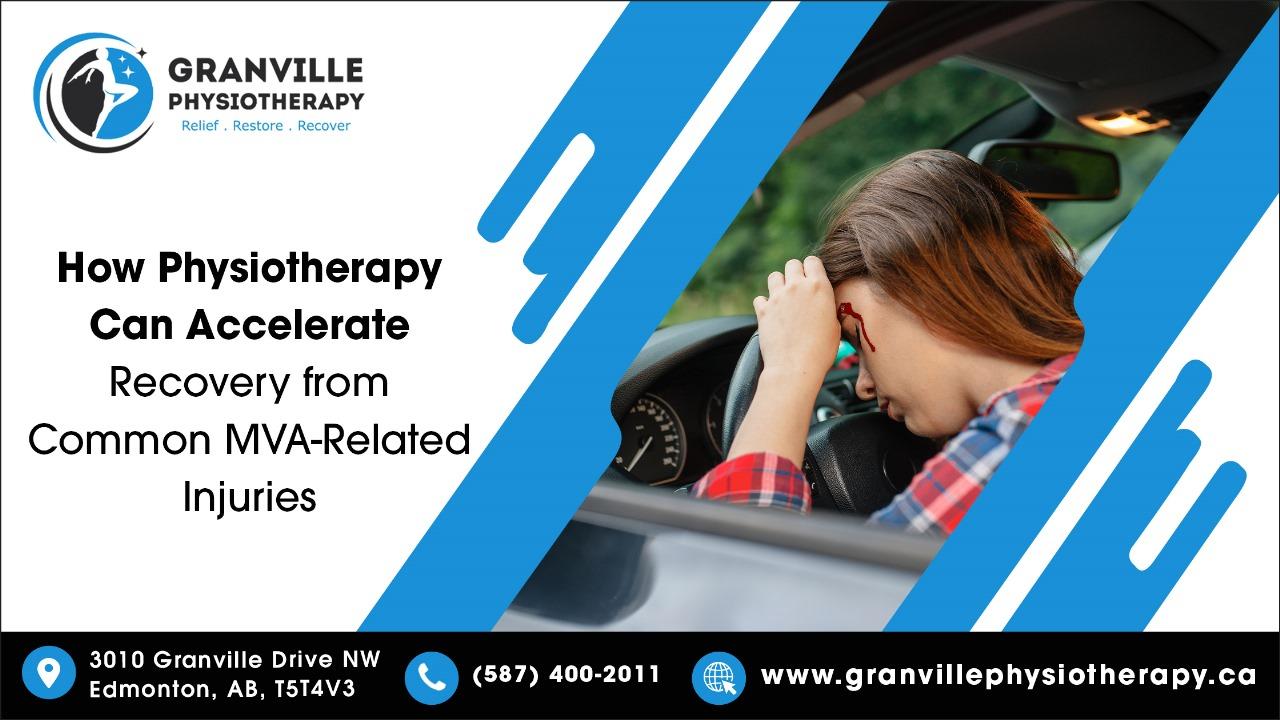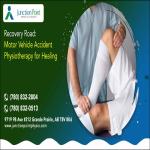Motor vehicle accident physiotherapy(MVA), also known as car accident physiotherapy, focuses on treating individuals who have been injured due to a car accident. Motor vehicle accident physiotherapy in Edmonton aims to aid patients in their recovery from injuries sustained as a result of the car accident.
Common Motor Vehicle Accidents Injuries:
Whiplash:
A soft tissue injury is caused by sudden jerking of the head backward and then forward, often in rear-end collisions.
Fractures:
A common result of motor accidents, especially in high-impact collisions, which affects various body parts like arms, legs, ribs, pelvis, and skull.
Head injuries:
Varying from minor concussions to severe traumatic brain injuries (TBIs), often caused by impact with objects within the vehicle like the steering wheel or windshield.
Back injuries:
Resulting from motor accidents, including herniated discs, spinal cord injuries, and compression fractures, leading to chronic pain, limited mobility, and neurological issues.
Soft tissue injuries:
Apart from whiplash, car accidents can induce sprains, strains, bruises, and lacerations to muscles, tendons, and ligaments across the body.
The Role of Physiotherapy in Addressing Common Motor Vehicle Accidents Injuries:
Restoration of Mobility and Function:
Motor vehicle accident physiotherapy in Edmonton designs personalized exercise programs to restore mobility, strength, flexibility, and range of motion in injured areas. These exercises are tailored to the individual needs and limitations of each patient and are gradually progressed as the patient's condition improves. Here are some common types of exercises that may be incorporated:
Range of Motion (ROM) Exercises:
These exercises aim to enhance joint flexibility and mobility. They may include gentle stretches, joint mobilizations, and range of motion exercises for affected body parts, such as the neck, shoulders, back, hips, knees, and ankles.
Strength Training:
Strengthening exercises help rebuild muscle strength that may have been lost due to injury or immobility. These exercises target specific muscle groups involved in stabilizing and supporting injured areas. For example, core strengthening exercises are often prescribed to improve stability in the spine and pelvis.
Balance and Proprioception Training:
Balance and proprioception exercises help improve coordination, postural control, and body awareness, which are essential for safe movement and preventing falls. These exercises may involve standing on unstable surfaces, using balance boards or stability balls, and performing single-leg balance drills.
Functional Movement Training:
Functional movement exercises simulate real-life activities and movements to improve functional mobility and performance. Examples include squatting, lunging, bending, reaching, lifting, and carrying activities that mimic daily tasks or work-related activities.
Gait Training:
Gait training focuses on improving walking and mobility patterns. Physiotherapists may assess and correct gait abnormalities, such as limping or uneven weight distribution, and prescribe exercises to improve walking symmetry, stride length, and overall gait mechanics.
Postural Correction Exercises:
Postural exercises target imbalances and dysfunctions in posture that may result from MVA-related injuries. These exercises aim to restore proper alignment, strengthen weak muscles, and release tight muscles to promote optimal posture and spinal alignment.
Prevention of Secondary Complications:
Prolonged immobility following an MVA can lead to secondary complications such as muscle stiffness, weakness, and joint contractures. Physiotherapy interventions, including therapeutic exercises and manual therapy techniques, help prevent these complications by promoting circulation, tissue healing, and optimal joint function. Here are some common interventions used in MVA physiotherapy in Edmonton to prevent secondary complications:
Manual Therapy Techniques:
Hands-on manual therapy techniques such as massage, joint mobilization, and soft tissue mobilization are employed to minimize muscle tension, improve circulation, and enhance tissue healing. Manual therapy can also help alleviate pain, improve joint range of motion, and prevent the formation of scar tissue.
Stretching:
Gentle stretching exercises are prescribed to improve muscle flexibility and joint mobility, thereby reducing the risk of developing joint stiffness and contractures. Stretching routines are tailored to target specific muscles and joints affected by the MVA injuries, and they are performed within the patient's pain tolerance.
Promotion of Healing:
Physiotherapy modalities such as ultrasound, electrical stimulation, and therapeutic laser may be used to promote tissue healing and reduce inflammation in injured areas. These modalities can enhance the body's natural healing processes and accelerate recovery. Here are some common modalities used for the promotion of healing:
Ultrasound Therapy:
This uses high-frequency sound waves to generate deep tissue heat, enhancing blood flow, reducing inflammation, and aiding tissue healing. It's commonly applied to treat soft tissue injuries like muscle strains, ligament sprains, and tendonitis.
Electrical Stimulation:
Electrical stimulation applies electrical currents to trigger muscle contractions or target specific nerves. Various forms, including TENS or NMES, are utilized in MVA physiotherapy to ease pain, lessen muscle spasms, and enhance circulation to injured tissues.
Heat Therapy:
Heat therapy, using moist heat packs or heating pads, boosts blood flow to the injured region, easing muscle tension and pain. Vasodilation, promoted by heat, enhances oxygen and nutrient delivery to tissues, aiding healing. It's commonly combined with other treatments and exercises to maximize outcomes.
Cold Therapy (Cryotherapy):
Cold therapy, like ice packs, reduces inflammation, numbs pain, and controls swelling after acute injuries by inducing vasoconstriction. This minimizes tissue damage and aids pain management during early rehabilitation.
Empowering Recovery:
Motor vehicle accident physiotherapy in Edmonton plays a crucial role in the comprehensive recovery process following motor vehicle accidents. By addressing a wide range of injuries and employing various therapeutic modalities, Granville Physiotherapy in Edmonton assists individuals in regaining mobility, reducing pain, and improving overall function. Through personalized treatment plans and ongoing support, patients can embark on a journey toward restored health and well-being, empowering them to resume their daily activities with confidence and resilience.
Also read about: Best Furniture For Home in Dubai










